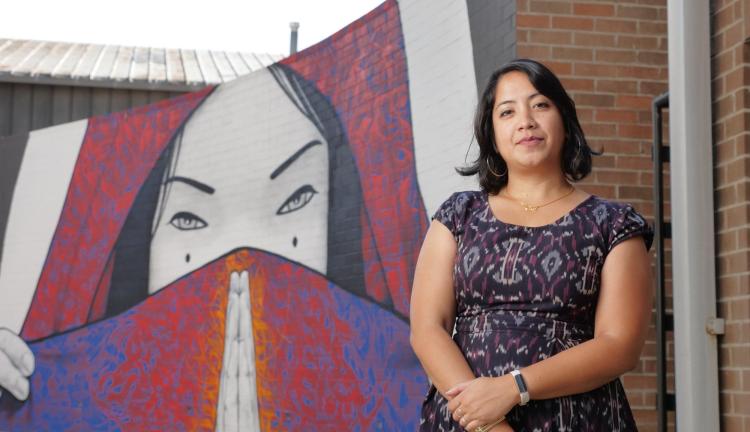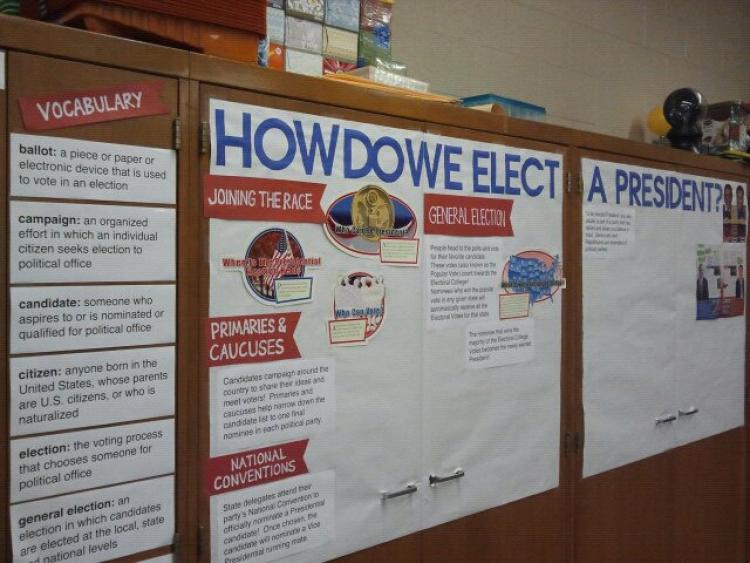As schools become political battlegrounds, one educator sees room for hope

Noreen Naseem Rodríguez stands in front of a mural in Denver's RiNo neighborhood by artists Casey Kawaguchi and Imagine876. (Credit: Casey Cass/CU Boulder)
When Noreen Naseem Rodríguez was 32, she stumbled on a few sentences in a book that changed the course of her work as an educational researcher: In 1587, she read, Filipino sailors aboard the merchant ship Nuestra Señora de Buena Esperanzalanded in Morro Bay, California—more than 30 years before Pilgrims on the Mayflower landed at Plymouth, Massachusetts.
Rodríguez, now 41, grew up in Texas to parents from Pakistan and the Philippines. But when she was in school, she rarely got to learn about the lives of Asian Americans like her.
If one of my history teachers had told me about that ship, I would have cared a whole lot more about social studies in school,” Rodríguez said. “To know that we had been there before the founding of the nation would have made me feel like I belonged in a different kind of way.”
She’s dedicated her career to making sure young people today have better experiences in the classroom than she did. Rodríguez taught bilingual education in elementary schools in Texas for nine years and earned her doctorate in curriculum and instruction from the University of Texas at Austin. She’s now an assistant professor in the School of Education at CU Boulder. Rodríguez believes classrooms become more vibrant, interesting and just places when children can learn about a wide range of American stories—not just those of the white men that show up in most history textbooks.
She laid out those ideas in a book published in 2022 called Social Studies for a Better World.
“Teaching social studies the same way we did 20 or 30 years ago is not OK,” Rodríguez said.
It's a stance that touches on an increasingly contentious debate among some parents and politicians. Across the country, dozens of states have passed or are considering laws that limit how teachers can talk about issues like race and racism, gender and sexuality in the classroom. This year, the Colorado State Board of Education is slated to approve a set of new social studies standards for K-12 students. Board members, legislators, parents, educators and more have sparred over how often the standards should mention marginalized groups like people of color and the LGBTQ community.
Rodríguez, however, urges educators not to shrink away from having “difficult conversations” with their students.
“If kids are asking questions about racism or gender at school, it's because they want to know, and they see their teacher as someone who can help them understand,” Rodríguez said. “So if kids are bringing these conversations to you, I tell my student-teachers not to shut that down.”
Texas’ cattle queen
She’s seen firsthand the value of learning history outside of traditional textbooks.
I have two kids who are in public schools, and I believe in public schools. I have to hope that education has a purpose, and that by working with teachers and future teachers, my kids will have a better experience than I did.”
—Noreen Naseem Rodríguez
In 2011 and 2012, Rodríguez and her fourth-grade students in Austin, Texas, got the opportunity to take part in the Tejano History Curriculum Project—an effort that sought to recognize the contributions of Mexican Americans in the Lone Star State. Together, they learned about Rosa María Hinojosa de Ballí, a woman who owned 55,000 acres of land in the 1700s and is sometimes called “the first cattle queen of Texas.” They also learned about Rodolfo “Corky” Gonzales, a Coloradan whose family was from Texas and helped to found a civil rights movement called the Crusade for Justice in Denver.
Rodríguez felt that she and her students were exploring a hidden world together.
“My white students, Mexican American students, my Black students—they were all really into learning about these histories,” she said. “We went through the index of our textbooks, and none of this stuff was in there.”
She also worries these kinds of experiences are growing more and more rare in the U.S.
The educator explained that teachers around the country face stiff pressure to teach the subjects that will appear on standardized tests: usually just reading, writing and math. Social studies—a field that includes history, economics and civics—has begun to disappear from elementary school curricula almost entirely.
“During the election in 2020, a lot of schools told their teachers not to talk about it,” Rodríguez said. “Something as important as how the country selects its president wasn’t being taught because people thought it was too controversial.”
Radical hope
Children’s books by the numbers
The Cooperative Children’s Book Center at the University of Wisconsin-Madison conducts an annual analysis of children’s books published in the U.S. The 3,751 books published in 2019 were about characters from the following backgrounds:
- 12% (459 books): Black/African
- 9% (336 books): Asian
- 6% (235 books) Latinx
- 1% (45 books): Indigenous
- <1% (33 books): Arab
- <1% (5 books): Pacific Islander
People who exist on the margins of our society rarely encounter books that serve as mirrors in school.”
—Noreen Naseem Rodríguez
To keep social studies alive, Rodríguez has embraced what may be the most controversial three words in education today: critical race theory.
The concept emerged from law schools in the 1970s and 1980s and is in its most basic sense “a way to understand the ways in which race and racism have been deeply embedded into the laws of this country,” Rodríguez said.
In recent years, however, politicians such as Florida Gov. Ron DeSantis have cast it in a different light, referring to critical race theory as “state-sponsored racism.”
Rodríguez believes many people in the U.S. misunderstand what critical race theory is actually about—it isn’t about teaching kids to hate each other, she said, but exploring the lasting legacy of racist laws in the country and ending “all forms of oppression.” No K-12 schools in the U.S. currently teach the concept. But in an edited book that will appear later this year called Critical Race Theory and Social Studies Futures, she and her colleagues ask the question: What if schools did teach students about how policies such as redlining kept generations of Black people from owning property; how the Voting Rights Act of 1965 was critical for expanding the right to vote to all people in the country; and how, until the 1960s, decades of laws effectively banned people from Asia like Rodríguez’ family from emigrating to the U.S.
She argues racism is woven into the lives of young people of color, whether politicians want to acknowledge it or not. If teachers can recognize this reality, they may be able to help their students build empathy for each other.
“If kids could learn about these issues, they would have a better understanding of the history of race and racism in this country,” Rodríguez said. “Because that matters. That history is part of why we continue to see injustice today.”
Despite the current environment for K-12 educators, Rodríguez said she’s never given up what she calls “radical hope.” Like the title of her earlier book suggests, she believes a few dedicated teachers and more expansive social studies curricula can make a better world.
“I have two kids who are in public schools, and I believe in public schools,” Rodríguez said. “I have to hope that education has a purpose, and that by working with teachers and future teachers, my kids will have a better experience than I did.”



